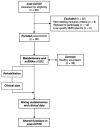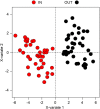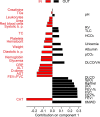The biomarkers' landscape of post-COVID-19 patients can suggest selective clinical interventions
- PMID: 38110483
- PMCID: PMC10728085
- DOI: 10.1038/s41598-023-49601-4
The biomarkers' landscape of post-COVID-19 patients can suggest selective clinical interventions
Abstract
In COVID-19 clinical symptoms can persist even after negativization also in individuals who have had mild or moderate disease. We here investigated the biomarkers that define the post-COVID-19 clinical state analyzing the exhaled breath condensate (EBC) of 38 post COVID-19 patients and 38 sex and age-matched healthy controls via nuclear magnetic resonance (NMR)-based metabolomics. Predicted gene-modulated microRNAs (miRNAs) related to COVID-19 were quantified from EBC of 10 patients and 10 controls. Finally, clinical parameters from all post-COVID-19 patients were correlated with metabolomic data. Post-COVID-19 patients and controls showed different metabolic phenotype ("metabotype"). From the metabolites, by using enrichment analysis we identified miRNAs that resulted up-regulated (hsa-miR146a-5p) and down-regulated (hsa-miR-126-3p and hsa-miR-223-3p) in post-COVID-19. Taken together, our multiomics data indicate that post-COVID-19 patients before rehabilitation are characterized by persistent inflammation, dysregulation of liver, endovascular thrombotic and pulmonary processes, and physical impairment, which should be the primary clinical targets to contrast the post-acute sequelae of COVID-19.
© 2023. The Author(s).
Conflict of interest statement
The authors declare no competing interests.
Figures






Similar articles
-
Differential microRNA expression in the peripheral blood from human patients with COVID-19.J Clin Lab Anal. 2020 Oct;34(10):e23590. doi: 10.1002/jcla.23590. Epub 2020 Sep 22. J Clin Lab Anal. 2020. PMID: 32960473 Free PMC article.
-
Exosomal miR-17-5p, miR-146a-3p, and miR-223-3p Correlate with Radiologic Sequelae in Survivors of COVID-19-Related Acute Respiratory Distress Syndrome.Int J Mol Sci. 2023 Aug 22;24(17):13037. doi: 10.3390/ijms241713037. Int J Mol Sci. 2023. PMID: 37685844 Free PMC article.
-
Development and validation of exhaled breath condensate microRNAs to identify and endotype asthma in children.PLoS One. 2019 Nov 8;14(11):e0224983. doi: 10.1371/journal.pone.0224983. eCollection 2019. PLoS One. 2019. PMID: 31703106 Free PMC article.
-
Identification of the differential expression of genes and upstream microRNAs in small cell lung cancer compared with normal lung based on bioinformatics analysis.Medicine (Baltimore). 2020 Mar;99(11):e19086. doi: 10.1097/MD.0000000000019086. Medicine (Baltimore). 2020. PMID: 32176034 Free PMC article.
-
MicroRNA expression in male infertility.Reprod Fertil Dev. 2022 Jul;34(12):805-818. doi: 10.1071/RD21131. Reprod Fertil Dev. 2022. PMID: 35760398 Review.
Cited by
-
A Review on Long COVID Screening: Challenges and Perspectives Focusing on Exhaled Breath Gas Sensing.ACS Sens. 2025 Mar 28;10(3):1564-1578. doi: 10.1021/acssensors.4c02280. Epub 2024 Dec 16. ACS Sens. 2025. PMID: 39680873 Free PMC article. Review.
-
Clinical-based phenotypes in children with pediatric post-COVID-19 condition.World J Pediatr. 2024 Jul;20(7):682-691. doi: 10.1007/s12519-024-00805-2. Epub 2024 Apr 25. World J Pediatr. 2024. PMID: 38664324 Free PMC article.
-
Metabolic signatures of acute respiratory distress syndrome: COVID versus non-COVID.Am J Physiol Lung Cell Mol Physiol. 2024 May 1;326(5):L596-L603. doi: 10.1152/ajplung.00266.2023. Epub 2024 Mar 12. Am J Physiol Lung Cell Mol Physiol. 2024. PMID: 38469648 Free PMC article. Review.
-
Molecular profiling of exhaled breath condensate in respiratory diseases.Ann Med. 2025 Dec;57(1):2537910. doi: 10.1080/07853890.2025.2537910. Epub 2025 Jul 24. Ann Med. 2025. PMID: 40708204 Free PMC article. Review.
-
Treatment with Sulodexide Downregulates Biomarkers for Endothelial Dysfunction in Convalescent COVID-19 Patients.Clin Appl Thromb Hemost. 2025 Jan-Dec;31:10760296241297647. doi: 10.1177/10760296241297647. Clin Appl Thromb Hemost. 2025. PMID: 39763448 Free PMC article. Clinical Trial.
References
-
- National Institute for Health and Care Excellence. Royal College of General Practitioners. Healthcare Improvement Scotland SIGN . COVID-19 Rapid Guideline: Managing the Long-Term Effects of COVID-19. National Institute for Health and Care Excellence; 2020.
MeSH terms
Substances
Grants and funding
LinkOut - more resources
Full Text Sources
Medical

